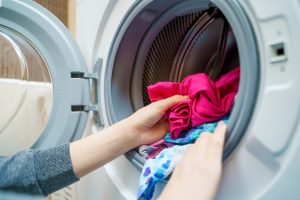In recent months, customs controls in Kazakhstan have tightened, and the effects are starting to be felt in Russia. As Astana tries to avoid secondary sanctions, the country has begun to crack down on efforts to circumvent sanctions by routing goods through Kazakhstan. While Russia has legalized so-called parallel imports — the supply of products without the copyright holder’s permission — Kazakhstan has decided to block such transactions.
Many companies, like Samsung, LG, Apple, Bosch, and others, opted to slow or pause sales in Russia in response to the invasion of Ukraine. Yet these goods are sold in nearby countries, like Kazakhstan and Uzbekistan, which can serve as transit points for in-demand items.
Washing machines are one example. As the Financial Times reported in March: “the number of washing machines exported to Russia from Kazakhstan rose from zero in 2021 to almost 100,000 in 2022.”
In March, Eurasianet’s Joanna Lillis reported that as of April 1 Kazakhstan aimed to introduce an online system “designed to track all goods entering and exiting the country” in order to “demonstrate compliance with Western efforts to isolate Russia’s economy in reprisal for the ongoing invasion of Ukraine.”
Earlier that month Reuters had reported on a stark rise in requests from Russian companies to their counterparts in Kazakhstan to help import a huge range of goods, everything from rare earth metals to turbines, railway bearings to plastic bank cards.
This week Kommersant, a Russian paper, reported that the cost of electronics and household appliances may increase by 10-12 percent due to new restrictions at the Kazakh border, suggesting that the the April implementation of Astana’s new system is having an impact, at least on the planning of Russian importers. Russian companies reportedly have begun to turn to other alternative routes, such as through China, Kyrgyzstan, the United Arab Emirates, and other countries, but the costs are rising.
The introduction of a system to track imports and exports addresses the fact that Russia’s and Kazakhstan’s economies are tangled together. As members of the Eurasian Economic Union (EAEU), trade is supposed to move smoothly across their border. And in the early months of Russia’s war in Ukraine, Kazakhstan saw a spike in trade. Exports from Kazakhstan to Russia in 2022 rose by a quarter, up to $8.8 billion.
Given the technology involved in modern appliances, European officials aired concerns in late March that Moscow may be extracting semiconductors from washing machines and cameras, turning objects not necessarily associated with the military-industrial complex into dual-use goods.
It’s clear that Astana remains wary of coming under secondary sanctions. In late April, senior U.S. Treasury and Commerce officials traveled to Kazakhstan, including Assistant Secretary for Terrorist Financing and Financial Crimes at the U.S. Department of the Treasury Elizabeth Rosenberg and Assistant Secretary for Export Enforcement at the U.S. Department of Commerce Matthew Axelrod. The U.S. government readout of the visit heralds Kazakhstan as a close partner in “countering the evasion of sanctions and export controls imposed on Russia for its war against Ukraine.” The statement went on to note that “Axelrod shared the importance to Russia of acquiring specific semiconductors and other electronic integrated circuits to power its missiles and drones, and stressed the urgency of preventing Russia from evading coalition export restrictions by transshipping such items through Kazakhstan.”
A less rosy interpretation of the visit is as a warning: The U.S. side communicating that it’s known that these goods are transiting Kazakhstan into Russia. And so, shutting down parallel imports is a big step for Kazakhstan but likely a necessary one to avoid the secondary sanctions it has worried about since the start of the war.
































